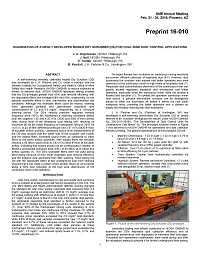Mining Publication: Examination of a Newly Developed Mobile Dry Scrubber (DS) for Coal Mine Dust Control Applications
Original creation date: February 2016
A self-tramming remotely controlled mobile Dry Scrubber (DS) was developed by J. H. Fletcher and Co. under a contract with the National Institute for Occupational Safety and Health's Office of Mine Safety and Health Research (NIOSH OMSHR) to reduce exposure of miners to airborne dust. NIOSH OMSHR laboratory testing showed that the DS averaged greater than 95% dust removal efficiency with the disposable filters and averaged 88% and 90%, respectively, for the optional washable filters in their pre-washed and post-washed test conditions. Although the washable filters could be reused, washing them generated personal and downstream respirable dust concentrations of 1.2 and 8.3 mg/m3, respectively, for a 10-minute washing period. The DS's velocity pressure regulated variable frequency drive (VFD) fan maintained a relatively consistent airflow near the targeted 1.43 and 4.25 m3/s (3000 and 9000 ft3/min) airflow rates during most of the laboratory dust testing until reaching its maximum 60 Hz fan motor frequency or horsepower rating at 2610 Pa (10.5 in. w.g.) of filter differential pressure and 3.97 m3/s (8420 ft3/min) of scrubber airflow quantity. Laboratory sound level measurements of the DS also showed that the outlet side of the scrubber was noisier and the loaded filters increased sound levels as compared to clean filters at the same airflow quantities. With loaded filters the scrubber reached a 90 dB(A) sound level at 2.83 m3/s (6000 ft3/min) of scrubber airflow, indicating that miners should not be overexposed in relation to MSHA's permissible exposure level (PEL) of 90 dB(A) at or below this airflow quantity. The DS's washable filters were not used during field testing because of their lower respirable dust removal efficiency and the airborne dust generated from filter washing. Field testing the DS with the disposable filters at two underground coal mine sections showed that it can clean a portion of the section return air and provide about a 50% dust reduction at the face area downstream of the continuous miner (CM) operation.
Authors: JA Organiscak, JD Noll, DS Yantek, B Kendall
Conference Proceedings - February 2016
NIOSHTIC2 Number: 20048267
2016 SME Annual Meeting, February 21-24, 2016, Phoenix, Arizona, preprint 16-010. Englewood, CO: Society for Mining, Metallurgy, and Exploration, Inc., 2016 Feb; :1-7
See Also
- Best Practices for Dust Control in Coal Mining
- Coal Dust Explosibility Meter Evaluation and Recommendations for Application
- Continuous Miner Spray Considerations for Optimizing Scrubber Performance in Exhaust Ventilation Systems
- Control of Respirable Dust
- Deposition Uniformity of Coal Dust on Filters and its Effect on the Accuracy of FTIR Analyses for Silica
- Evaluating Portable Infrared Spectrometers for Measuring the Silica Content of Coal Dust
- Investigation into Dust Exposures and Mining Practices in Mines in the Southern Appalachian Region
- Laboratory Evaluation of a Canopy Air Curtain for Controlling Occupational Exposures of Roof Bolters
- NIOSH Hazard ID 1 - Exposure to Silica Dust on Continuous Mining Operations Using Flooded-Bed Scrubbers
- A Review of Occupational Silica Exposures on Continuous Mining Operations
- Page last reviewed: 3/14/2017
- Page last updated: 9/12/2016
- Content source: National Institute for Occupational Safety and Health, Mining Program


 ShareCompartir
ShareCompartir
